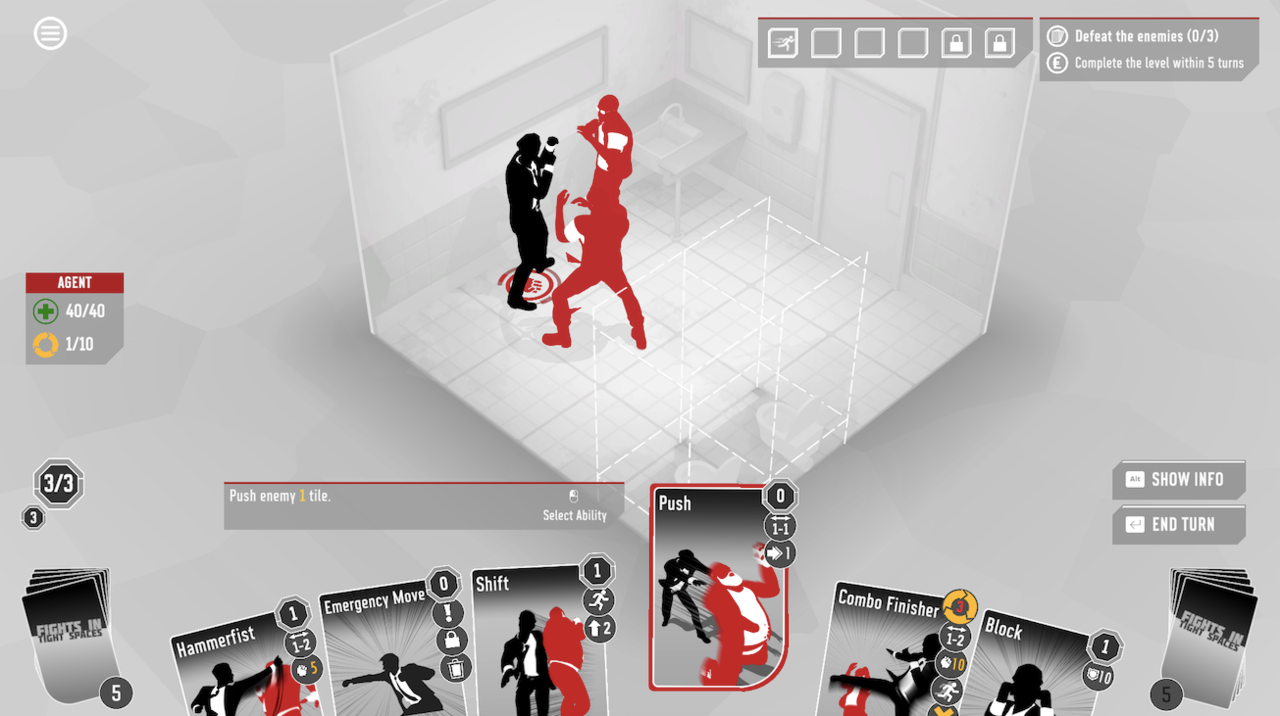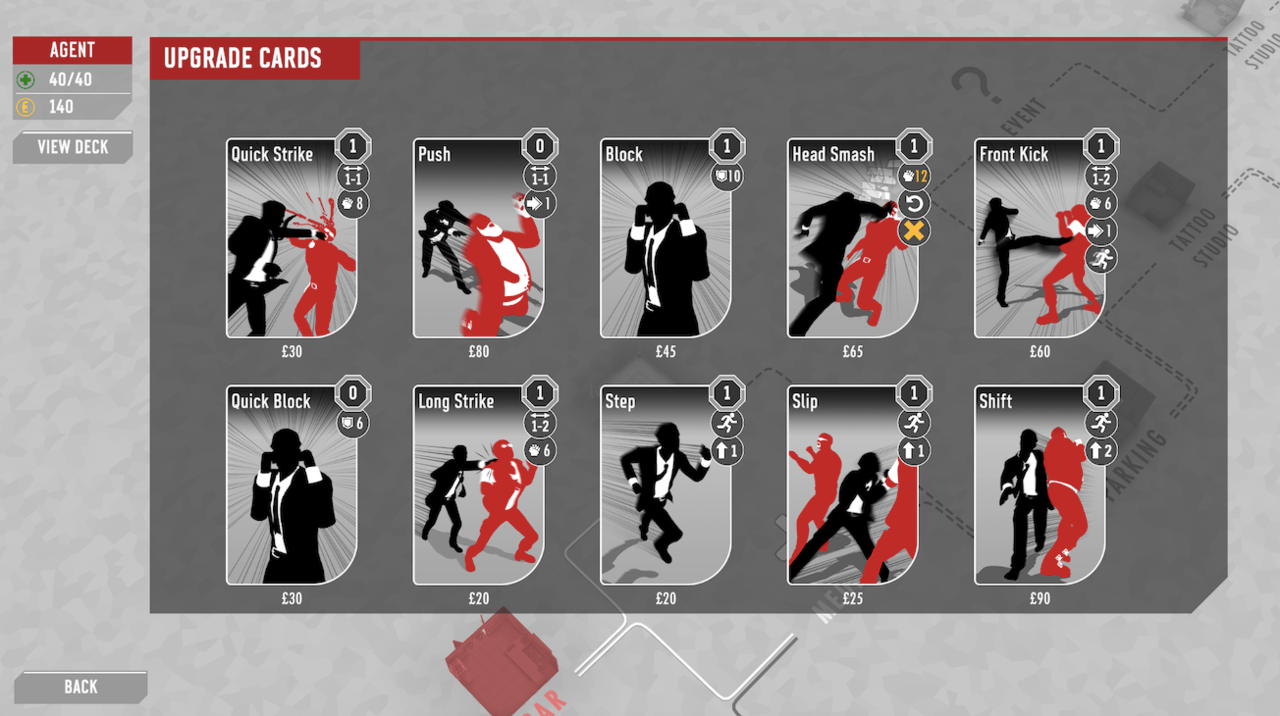If the fights in John Wick were choreographed by the plays you made with a deck of cards, you'd get Fights in Tight Spaces. The roguelite deck-builder puts you in increasingly cramped and intricate spaces, challenging you with figuring out an efficient and safe way to punch, kick, and outsmart every enemy stuffed in there with you. It's a fascinating mix of recognizable genres that produces something distinct and satisfyingly complex, even in its Early Access state.
Fights in Tight Spaces currently features the core loop of the game spread out across five stages, each their own unique enemies, rewards, and final boss fights. You have four styles of play to choose from, with decks of moves focused on counter-attacking, all-out assault, or combinations of the two. Each run is unique, too, shaped by the small decisions you make regarding what routes to take in each stage. These influence what rewards you might get out of each fight, what vendors you'll have access to, and what random events you can happen upon. Die, however, and everything resets, without any persistence between runs to make the next one any easier.
Each themed stage is littered with levels you need to complete, with the namesake of the game coming to fruition in their design. Each level plays out across a tile-based grid, with enemies randomly placed throughout. You use cards to initiate actions--moving to adjacent tiles, attacking enemies, or more complex combinations of the two--with action points restricting how many cards you can play per turn. These are densely-packed grids, sometimes as small as 4x6 battle arenas that make just avoiding attacks a delicate dance. Like other tactical games like Into the Breach, you have to use every tile to your advantage. Enemies prepare attacks should you come within range at any point during your turn, and will execute them regardless of whether you leave that space by the end. This means turns aren't solely about using your limited action points to dole out damage, but also trying to position other foes in the line of fire of their comrades.

Your actions are determined by a hand of cards you're dealt at the start of each turn, with your entire hand being reshuffled when it ends. This prevents you from keeping cards that you might foresee as useful in the future and, quite literally, forces you to work with the hand that you're dealt. Actions can range from simple tile movements to flying kicks that knock enemies back or smooth shuffles that let you slink around an enemy blocking your path. Cards also feature unique modifiers, like stunning enemies or forcing a foe to face you once you've struck. Some cards also influence a separate momentum counter that is required for some attacks, with most strikes adding to it while tile movements subtract from the same tally.
There's a lot more to consider than just the damage you deal when playing a card, and it's initially overwhelming to try and understand how each one works in tandem with the others. The tutorial is also brief, exposing you to each mechanic individually but not fully exploring complex scenarios that might better show off their synergy. You discover this through each run, but it can be annoying to suffer through bad moves because you missed out on a single effect on a card stacked with them. The dozens of tooltips do help you sift through all the information during your turns, but the limited tutorial leaves you with an overwhelming amount of stuff to learn in runs that punish very small mistakes.
This is especially true when you start experimenting with cards that require more complex prerequisites to use, such as a devastating kick that requires a wall behind you to kick off of or grapples that can be used on specific enemies. Markers on the tiles give you a clear indication of where you can initiate a move, but not enough information at times to help you understand why you might not be able to use it. This can be frustrating as you're piecing together a string of moves from the cards you have, only to have your entire plan fall apart because it's not evident why you can't pull off the final finishing touch.
Thankfully this doesn't extend to the UI used to inform you of enemy attacks, which becomes important as foes and their attacks become more varied. While they start with simple ranged attacks and single-tile melee swings, new enemies eventually introduce area-of-effect attacks, dangerous rushes that can close the already limited space, and harmful stuns that can quickly have you overwhelmed. All of this is effectively communicated through colored tiles and dotted lines denoting ranges of attack, while tooltips help inform you when an enemy has been primed to attack on their turn. This helps you effectively map out the best strategy for each turn, while also doing a good job of letting you know when a move you've made has changed the behavior of any of the enemies around you.
Having to think about where you end your turn is just as vital as what actions lead you to that point, which can turn the otherwise limited action points into a pool of multiple strategic opportunities. Knowing how to string together the right combination of moves and position yourself perfectly for the wave of incoming attacks is incredibly satisfying, as is watching each of your attacks play out, spraying brightly colored red blood onto the monochromatic bathrooms, alleyways, or jail cells that comprise many of the level designs. At the end of each stage, you are treated to a replay of all your attacks played out in real time, but the tile-based nature of the gameplay makes this an awkwardly-animated cinematic that never flows as elegantly as you'd want it to.
Knowing how to string together the right combination of moves and position yourself perfectly for the wave of incoming attacks is incredibly satisfying.
The deck that you pull cards from each turn is initially determined by the play style you select before each run, and each stage you complete gives you opportunities to expand the deck's arsenal. Most fights give you a choice between three cards that you add to your deck, which in turn gives you more ways to deal with the increasingly challenging foes in subsequent levels. Certain vendors in each stage also give you the ability to purchase, upgrade, or get rid of cards from your deck, but getting to them requires you to often forgo the advantage of a clinic to heal or random event and its potential rewards. Plotting your route through each of the game's stages is as important a choice as each of your moves within its levels, where rash choices can often lead to a premature end to your run.
Currently, however, Fight in Tight Spaces' economy doesn't adequately reward you for taking routes with more fights. While each fight nets you some currency to spend at the aforementioned vendors, it's not nearly enough to cover the disproportionately high costs of healing, card upgrades, and more. It's disheartening to struggle through a string of fights and only be able to heal less than half of your current total before a boss encounter, for example. Similarly, hitting optional objectives in each stage (such as finishing in a limited number of moves or killing enemies in specific ways) doesn't reward you enough to justify the risk sometimes required, meaning I eventually actively ignored pursuing them.

This design forces you to rely more on your prowess in battles than your ability to remedy mistakes outside of them. But it can lead to runs feeling overly punishing, especially when each of the five stages are extensive challenges with more than a handful of levels. Given that your health persists between them, it's easy for just one bad fight to turn an entire run on its head without many avenues for you to recover. And because skipping the early stages puts you at a disadvantage--you'd only have starter decks and no upgrades--you're likely to feel more inclined to quit after a failed run, rather than dive into another immediately and repeat the same long, opening stages just to get a shot at the area you last failed on.
The roadmap for Fights in Tight Spaces does mention balancing and refinements to randomization, so it's possible that these issues can be remedied before the full release, which is planned for later this year. Also planned are additional stages and new bosses, as well as a daily run mode and new cards for you to build a deck with.
While the additional content is certainly welcomed, there's so much already here that you'd be forgiven assuming the game wasn't in Early Access. The core pillars that prop up its distinct premise are sound enough that playing through Fights in Tight Spaces tickles all the right strategy parts of the brain, providing satisfying victories when you've thought out your options just right. The additional development time afforded by Early Access could help smooth out some of the rough edges, making the future of this tactical deck-builder one to look out for.